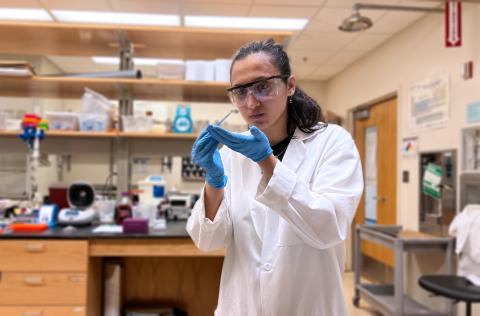Jarin’s dedication and accomplishments have garnered recognition, including winning prestigious awards. Most recently, Jarin’s research titled, “Operando investigation of the synergistic effect of electric field treatment and copper for bacteria inactivation,” was published in Nature Communications.
This is part two of the feature on Mo Jarin. Jarin is a Ph.D. student in environmental engineering who expects to graduate in May 2025. See part one here.
Jarin’s dedication and accomplishments have garnered recognition, including winning prestigious awards. Most recently, Jarin’s research titled, “Operando investigation of the synergistic effect of electric field treatment and copper for bacteria inactivation,” was published in Nature Communications.
Pioneering Safer Water Disinfection
At the forefront of her laboratory’s efforts to develop alternative water disinfection technologies, Jarin’s work offers promising solutions to mitigate the risks associated with traditional chlorine-based treatments.
Her lab’s innovative approach, Locally Enhanced Electric Field Treatment (LEEFT), harnesses the power of enhanced electric fields and copper ions to eliminate waterborne pathogens without relying on chlorine.
The Promise of Copper-Based Technology
Through meticulous observation, Jarin uncovered crucial insights into LEEFT’s mechanisms when combined with copper. The research published in Nature Communications focused on understanding this mechanism in ways we can’t observe with the naked eye.
“What we found is that the electric field will weaken the membranes of these potential pathogens, allowing copper to have a much stronger and faster effect in killing them,” said Jarin.
Beyond the laboratory, Jarin envisions practical applications for LEEFT in environments like swimming pools and hot tubs, where reducing chlorine reliance can minimize health and environmental risks.
Looking ahead, Jarin is committed to advancing her research and realizing the potential of the LEEFT technology. Her end goal is to retrofit LEEFT like a smart pipe into the water distribution pipelines, so that it can provide antimicrobial power over the entire distribution system.
“We’re years away, but we’re getting close to an applicable prototype,” said Jarin. “We need a lot of upgrading of our water infrastructure, especially in the U.S., and it can also be very impactful to the rest of the world.”
As she marches forward towards her goal of implementing LEEFT technology into water distribution systems, Jarin's impact extends far beyond the laboratory, promising a safer and healthier tomorrow for communities everywhere.
Stay tuned for part three of Jarin’s story as she delves deeper into experiences in entrepreneurship, reflects on challenges overcome, and shares cherished, memories from her time at Tech.
